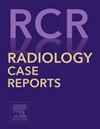经皮经肝血管栓塞治疗肠系膜动静脉畸形导致酒精性肝硬化患者门静脉压力下降1例报告
Q4 Medicine
引用次数: 0
摘要
动静脉畸形在腹部区域是罕见的,他们是已知的偶尔引起门静脉高压症。66岁男性,主诉疲劳,血液检查显示肝功能不全,接受详细检查。腹部增强计算机断层扫描显示回肠动脉和回肠静脉通过肠系膜内的病灶吻合。除了高酒精摄入史导致的酒精性肝硬化外,患者还因肠系膜动静脉畸形导致的门静脉压力增加而被诊断为门静脉高压。经皮经肝入路血管栓塞治疗肠系膜动静脉畸形。作为主要流出静脉的回肠静脉被栓塞,动静脉畸形血流消失。经证实门静脉压力下降29%。栓塞无并发症发生。在肠系膜动静脉畸形导致门静脉高压症的病例中,对畸形的治疗可以降低门静脉压力。与外科肠切除术相比,低侵入性的血管内治疗被认为是一种可能的选择。本文章由计算机程序翻译,如有差异,请以英文原文为准。
Percutaneous transhepatic vascular embolization for a mesenteric arteriovenous malformation leading to decreased portal pressure in a patient with alcoholic liver cirrhosis: A case report
Arteriovenous malformations in the abdominal region are rare, and they are known to occasionally cause portal hypertension. A 66-year-old man with a chief complaint of fatigue and blood tests showing hepatic dysfunction was seen for a more detailed examination. Abdominal contrast-enhanced computed tomography showed an anastomosis of the ileal artery and ileal vein via a nidus within the mesentery. In addition to alcoholic cirrhosis from a history of high alcohol intake, the patient was diagnosed with portal hypertension from increased portal pressure due to an arteriovenous malformation in the mesentery. Vascular embolization with a percutaneous transhepatic approach was performed for the mesenteric arteriovenous malformation. The ileal vein, which was the dominant outflow vein, was embolized, and the blood flow in the arteriovenous malformation disappeared. A decrease in portal pressure of 29% was confirmed. There were no complications from the embolization. In cases of mesenteric arteriovenous malformations that contribute to portal hypertension, treatment of the malformations can be expected to decrease portal pressure. Compared with surgical intestinal resection, endovascular treatment that can be done with low invasiveness is thought to be a possible option.
求助全文
通过发布文献求助,成功后即可免费获取论文全文。
去求助
来源期刊

Radiology Case Reports
Medicine-Radiology, Nuclear Medicine and Imaging
CiteScore
1.10
自引率
0.00%
发文量
1074
审稿时长
30 days
期刊介绍:
The content of this journal is exclusively case reports that feature diagnostic imaging. Categories in which case reports can be placed include the musculoskeletal system, spine, central nervous system, head and neck, cardiovascular, chest, gastrointestinal, genitourinary, multisystem, pediatric, emergency, women''s imaging, oncologic, normal variants, medical devices, foreign bodies, interventional radiology, nuclear medicine, molecular imaging, ultrasonography, imaging artifacts, forensic, anthropological, and medical-legal. Articles must be well-documented and include a review of the appropriate literature.
 求助内容:
求助内容: 应助结果提醒方式:
应助结果提醒方式:


